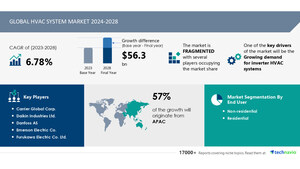NEW YORK, June 5, 2024 /PRNewswire/ -- The global thin-film batteries market size is estimated to grow by USD 4.77 billion from 2024-2028, according to Technavio. The market is estimated to grow at a CAGR of almost 33.39% during the forecast period.
For comprehensive forecast and historic data on regions, market segments, customer landscape, and companies- Click for the snapshot of this report
Thin-Film Batteries Market Scope |
|
Report Coverage |
Details |
Base year |
2023 |
Historic period |
2018 - 2022 |
Forecast period |
2024-2028 |
Growth momentum & CAGR |
Accelerate at a CAGR of 33.39% |
Market growth 2024-2028 |
USD 4778.8 million |
Market structure |
Fragmented |
YoY growth 2022-2023 (%) |
27.13 |
Regional analysis |
North America, APAC, Europe, South America, and Middle East and Africa |
Performing market contribution |
North America at 39% |
Key countries |
US, China, Germany, France, and Japan |
Key companies profiled |
Angstrom Engineering Inc., Avery Dennison Corp., Coreshell Technologies, Cymbet Corp., EIT InnoEnergy SE, Enfucell, Fujitsu Ltd., Imprint Energy, Jenax Inc., Koch Industries Inc., Kurt J Lesker Co., LG Corp., RRC power solutions GmbH, Samsung Electronics Co. Ltd., Shenzhen Grepow Battery Co. Ltd., Soleras Advanced Coatings BV, STMicroelectronics International N.V., The Swatch Group Ltd., and Ultralife Corp. |
Market Driver
The global thin-film batteries market is experiencing growth due to the rising demand for eco-friendly batteries. Thin-film batteries are preferred over conventional batteries due to their non-toxic materials and lower carbon footprint. This trend is driven by increasing environmental concerns, government regulations, and consumer preferences.
Countries are implementing policies to reduce carbon emissions and promote clean energy, leading to an increase in demand for eco-friendly batteries. Thin-film batteries are made from less toxic materials like copper, aluminum, and lithium, making them a more sustainable option. Manufacturers are investing in R&D to enhance performance and efficiency, further boosting adoption in various applications. This growing demand presents significant opportunities for the global thin-film batteries market.
The Thin-Film Battery market is experiencing significant growth due to the increasing demand for lightweight and flexible energy storage solutions. Consumers and industries alike are seeking advanced technologies that can power portable devices and electric vehicles with minimal weight and maximum efficiency. Companies are investing in research and development to create new and improved thin-film battery designs, such as Solid-State Thin-Film Batteries and Printed Thin-Film Batteries. T
hese innovations offer longer battery life, faster charging times, and increased safety compared to traditional batteries. Additionally, the use of conductive polymers and other advanced materials is enabling the production of thinner, more flexible batteries that can be integrated into various applications. Overall, the Thin-Film Battery market is poised for continued growth as the demand for lightweight, flexible, and efficient energy storage solutions increases.
Market Challenges
- Thin-film batteries face a significant challenge in the form of high manufacturing costs. This issue arises from the use of expensive materials like lithium, cobalt, and rare-earth elements, which are essential for production.
- The complex manufacturing process, involving deposition, patterning, and packaging, also contributes to the high cost due to the need for specialized equipment and skilled labor. Consequently, the high cost of thin-film batteries may discourage customers and hinder market growth, leading them to consider alternatives such as lithium-ion and solid-state batteries.
- The Thin-Film Battery market faces several challenges. Devices, such as capacitors and batteries, are essential components in this industry. Manufacturing processes involve the use of materials like lithium and flexible electronics.
- However, producing these batteries at a large scale presents challenges. Cost is a significant factor. The production process for thin-film batteries is complex and requires specialized equipment. This increases the cost per unit, making it difficult for manufacturers to compete with traditional battery technologies.
- Another challenge is the limited energy density of thin-film batteries. They cannot store as much energy as other types of batteries, which limits their use in applications where high energy storage is required. Additionally, the durability of thin-film batteries is a concern. They are more susceptible to damage due to their thin and flexible nature.
- This can lead to shorter battery life and increased replacement costs. Despite these challenges, research and development efforts continue to address these issues. Innovations in manufacturing processes, materials, and design are expected to improve the cost, energy density, and durability of thin-film batteries.
Research report provides comprehensive data on impact of trend, driver and challenges - Request a sample report!
Segment Overview
- End-user
- 1.1 Smart wearables
- 1.2 Smart cards
- 1.3 Medical devices
- 1.4 Others
- Battery Type
- 2.1 Rechargeable
- 2.2 Disposable
- Geography
- 3.1 North America
- 3.2 APAC
- 3.3 Europe
- 3.4 South America
- 3.5 Middle East and Africa
1.1 Smart wearables- The thin-film batteries market is experiencing growth due to the increasing demand for smart wearable devices in various industries. Nanotechnology and miniaturization drive the need for advanced battery solutions, specifically thin-film batteries, to power these devices. However, the size and weight constraints of wearables result in a tradeoff between battery size and capacity. Li-ion batteries, commonly used in wearables, have limited energy density.
To address this issue, manufacturers have adopted thin-film batteries, which offer increased capacity and longer battery life, benefiting both manufacturers and consumers. Smart wearable technology advancements continue to drive the global thin-film batteries market.
For more information on market segmentation with geographical analysis including forecast (2024-2028) and historic data (2017-2021) - Download a Sample Report
Research Analysis
The Thin-Film Batteries market encompasses innovative solutions in the realm of foldable electronics and wearables. These batteries, with their high energy density, cater to the demands of portable devices such as smartphones, tablets, and smart wearables. Thin-Film batteries offer extended recharge cycles, aligning with consumer preferences for longer device lifespans. Sustainable energy solutions are a significant focus in this market, with environmentally friendly and recyclable energy sources gaining traction.
IoT capabilities are integrated into these batteries, enhancing their functionality. Various types of Thin-Film batteries are under development, including flexible alkaline batteries, plastic batteries, and zinc-based flexible batteries. The market's growth is influenced by raw material costs, the availability of a skilled workforce, and infrastructural activities. Thin-Film batteries are poised to revolutionize the consumer electronics industry with their advanced features and eco-friendly attributes.
The Thin-Film Batteries market refers to the industry focused on producing and commercializing batteries with thin film structures. These batteries offer several advantages such as flexibility, lightweight, and high energy density. Thin-film batteries are primarily used in portable electronics, smartphones, and wearable devices. The technology behind these batteries involves the deposition of thin films of active materials onto substrates. Consumers are increasingly demanding longer battery life and lighter devices, making thin-film batteries an attractive solution.
The market for these batteries is expected to grow significantly due to the increasing demand for portable electronics and the ongoing research and development in battery technology. The use of sustainable and eco-friendly materials in the production of thin-film batteries is also a driving factor for market growth. The technology is constantly evolving, with new innovations and improvements being made to enhance the performance and efficiency of these batteries.
Table of Contents:
1 Executive Summary
2 Market Landscape
3 Market Sizing
4 Historic Market Size
5 Five Forces Analysis
6 Market Segmentation
- End-user
- Smart Wearables
- Smart Cards
- Medical Devices
- Others
- Battery Type
- Rechargeable
- Disposable
- Geography
- North America
- APAC
- Europe
- South America
- Middle East And Africa
7 Customer Landscape
8 Geographic Landscape
9 Drivers, Challenges, and Trends
10 Company Landscape
11 Company Analysis
12 Appendix
About Technavio
Technavio is a leading global technology research and advisory company. Their research and analysis focuses on emerging market trends and provides actionable insights to help businesses identify market opportunities and develop effective strategies to optimize their market positions.
With over 500 specialized analysts, Technavio's report library consists of more than 17,000 reports and counting, covering 800 technologies, spanning across 50 countries. Their client base consists of enterprises of all sizes, including more than 100 Fortune 500 companies. This growing client base relies on Technavio's comprehensive coverage, extensive research, and actionable market insights to identify opportunities in existing and potential markets and assess their competitive positions within changing market scenarios.
Contacts
Technavio Research
Jesse Maida
Media & Marketing Executive
US: +1 844 364 1100
UK: +44 203 893 3200
Email: [email protected]
Website: www.technavio.com/
SOURCE Technavio

WANT YOUR COMPANY'S NEWS FEATURED ON PRNEWSWIRE.COM?
Newsrooms &
Influencers
Digital Media
Outlets
Journalists
Opted In





Share this article